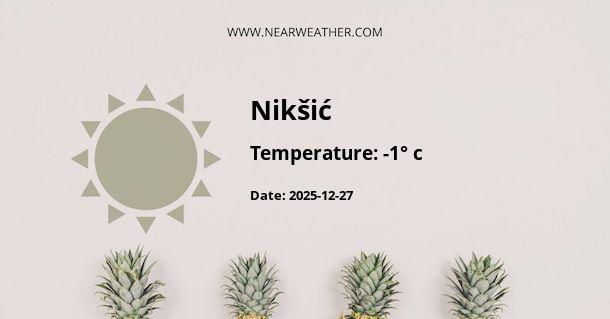Understanding the Climate and Weather in Nikšić, Montenegro
Nikšić, the second-largest city in Montenegro, is located in the west-central part of the country. Its climate and weather patterns are a reflection of its geographical position and topography. Nestled in a spacious valley at the foot of Mount Trebjesa, the city enjoys a temperate continental climate with Mediterranean influences. These climatic conditions bring about distinct seasonal variation, which plays a significant role in the region's culture, economy, and daily life.
Geographical Considerations
Nikšić's elevation, at approximately 630 meters above sea level, and its proximity to both the Adriatic Sea and the high mountain ranges, critically influence its climate. The interplay between the warm air masses coming from the sea and the cooler continental patterns can sometimes lead to unstable weather, particularly during the transitional periods of spring and fall.
Seasonal Weather Patterns
Winter
Winter in Nikšić typically extends from December to February. The season is characterized by colder temperatures often ranging from -3°C to 6°C. Snowfall can occur, but significant accumulations are not common every year. Humidity levels during this period tend to be higher, sometimes leading to foggy conditions, particularly in the mornings.
Spring
March to May witnesses a gradual increase in temperatures and a decrease in precipitation. As spring progresses, the average temperature varies from 5°C to 15°C. By late spring, the warmer days start to hint at the approaching summer season, with more sunlight hours encouraging the rebirth of the lush greenery in the region.
Summer
The summer, running from June to August, is characterized by warm to hot weather with average temperatures ranging from 14°C to 28°C. Occasional heatwaves can push temperatures even higher, especially in July, which is typically the hottest month of the year. During this period, Nikšić becomes a hub of activity with outdoor events and festivals taking advantage of the long, sunny days.
Fall
Autumn, which spans from September to November, sees a noticeable shift as the heat of the summer gives way to cooler and more unpredictable weather. The temperatures begin to drop back down, averaging between 6°C and 19°C. The rainfall increases, replenishing the land and preparing it for the upcoming winter.
Annual Climate Data
Below is a representation of the average climate data for Nikšić, which gives a clear picture of the temperature and precipitation patterns throughout the year. The table shows monthly average high and low temperatures, as well as average precipitation levels.
| Month | Average High (°C) | Average Low (°C) | Precipitation (mm) |
|---|---|---|---|
| January | 5.0 | -2.0 | 190 |
| February | 7.0 | -1.0 | 170 |
| March | 11.0 | 2.0 | 155 |
| April | 16.0 | 6.0 | 145 |
| May | 21.0 | 11.0 | 100 |
| June | 25.0 | 15.0 | 80 |
| July | 28.0 | 17.0 | 60 |
| August | 28.0 | 17.0 | 70 |
| September | 24.0 | 13.0 | 110 |
| October | 19.0 | 9.0 | 160 |
| November | 12.0 | 4.0 | 230 |
| December | 7.0 | 0.0 | 210 |
Extreme Weather Events and Climate Change Impacts
Nikšić, like many other regions, is not immune to the effects of climate change. In recent years, fluctuations such as warmer winters and unforeseen weather events like heavy rainfalls, have been noticed. These changes can potentially have substantial impacts on the local agriculture and hydrological regimes, as Nikšić relies heavily on its water resources both for drinking and for powering its hydropower plants.
"Climate change is reshaping weather patterns across the globe, and Nikšić experiences its effects through more pronounced seasonal extremes and variability."
Climate Influences on Local Life
The climate in Nikšić directly affects the daily life and economy of the region. Agriculture, viticulture, and dairy farming are important sectors that rely on the predictability of weather patterns. Moreover, cultural events and tourism are timed according to the more pleasant spring and summer months, making weather forecasting a critical component of planning and preparation.
Visiting Nikšić: Best Times and What to Expect
For tourists looking to explore Nikšić, the late spring and early fall are often considered the best times to visit. The milder weather during these times provides a comfortable environment for outdoor activities. Summer carries the allure of vibrant cultural festivals but requires preparation for higher temperatures.
Conclusion
The climate of Nikšić is illustrative of an intricate balance between continental and Mediterranean influences. Understanding the nuances of its climate not only helps in the practical aspects of planning and agriculture but also enriches the experience of those who reside in or visit this dynamic region of Montenegro.
Practical Advice for Residents and Visitors
- Be equipped for varying temperatures, especially if traveling in the transitional seasons of spring and fall.
- Keep an eye on local weather forecasts for potential unexpected changes, particularly if planning outdoor activities.
- Participate in local festivals and events which are often arranged to coincide with favorable weather conditions.
- Understand that although summers tend to be hot and dry, hydration and sun protection are important.
By paying attention to the local climate and weather patterns, one can fully appreciate the natural beauty and cultural richness that Nikšić has to offer.
A - Nikšić's Latitude is 42.773102 & Longitude is 18.944460.
A - Weather in Nikšić is 11° today.
A - Climate Conditions in Nikšić shows overcast clouds today.
A - Humidity in Nikšić is 88% today.
A - Wind speed in Nikšić is 7.96 km/h, flowing at 31° wind direction. today.
